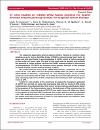In vitro studies on CNGRC-CPG2 fusion proteins for ligand-directed enzyme prodrug therapy for targeted cancer therapy

View/
Date
2020-02-01Author
Al-Mansoori, LaylaBashraheel, Sara S
Qahtani, Alanod D Al
O'Connor, C David
Elsinga, Philip
Goda, Sayed K
...show more authors ...show less authors
Metadata
Show full item recordAbstract
The sequence asparagine-glycine arginine (NGR), flanked by Cysteine (Cys) residues so as to form a disulfide-bridge (CNGRC), has previously been found to target and bind specifically to aminopeptidase N (APN), which is highly expressed on the surface of tumor cells. The goal of this study was to develop and evaluate the potential of fusion proteins carrying the CNGRC sequence linked to the enzyme carboxypeptidase G2 (CPG2) for targeted cancer therapy. We refer to this strategy as ligand-directed enzyme prodrug therapy (LDEPT). We constructed two forms of the CNGRC-CPG2 fusions, containing one or two copies of the cyclic NGR motif and designated CNGRC-CPG2 (X-CPG2) and CNGRC-CPG2-CNGRC (X-CPG2-X), respectively. binding assays of the purified constructs showed that both X-CPG2 and X-CPG2-X bound with high affinity to cancer cells expressing high levels of APN, compared to their binding to cells expressing low levels of APN. Further studies of the constructs to assess the therapeutic potential of LDEPT were carried out using cells expressing high and low levels of APN. Using methotrexate, it was demonstrated that cancer cell survival was significantly higher in the presence of the fusion proteins, due to the hydrolysis of this cytotoxic drug by CPG2. Conversely, when the prodrug ZD2767P was used, cancer cell killing was higher in the presence of the fused CPG2 constructs than in their absence, which is consistent with CPG2-mediated release of the cytotoxic drug from the prodrug. Furthermore, the doubly-fused CPG2 construct (X-CPG2-X) was significantly more effective than the singly-fused construct (X-CPG2).
Collections
- Biomedical Research Center Research [786 items ]
Related items
Showing items related by title, author, creator and subject.
-
Current Technologies and Future Perspectives in Immunotherapy towards a Clinical Oncology Approach
Adhikary, Subhamay; Pathak, Surajit; Palani, Vignesh; Acar, Ahmet; Banerjee, Antara; Al-Dewik, Nader I.; Essa, Musthafa M.; Mohammed, Sawsan G. A. A.; Qoronfleh, M. Walid... more authors ... less authors ( MDPI , 2024 , Article Review)Immunotherapy is now established as a potent therapeutic paradigm engendering antitumor immune response against a wide range of malignancies and other diseases by modulating the immune system either through the stimulation ... -
Current Technologies and Future Perspectives in Immunotherapy towards a Clinical Oncology Approach
Adhikary, Subhamay; Pathak, Surajit; Palani, Vignesh; Acar, Ahmet; Banerjee, Antara; Al-Dewik, Nader I.; Essa, Musthafa Mohamed; Mohammed, Sawsan G.A.A.; Qoronfleh, M. Walid... more authors ... less authors ( MDPI , 2024 , Article Review)Immunotherapy is now established as a potent therapeutic paradigm engendering antitumor immune response against a wide range of malignancies and other diseases by modulating the immune system either through the stimulation ... -
Tumor-type agnostic, targeted therapies make a new step forward: The first tumor-agnostic approval of a HER2-targeted therapy
Vranic, Semir; Gatalica, Zoran ( the Association of Basic Medical Sciences , 2024 , Article)Oncologic treatment has recently undergone substantial therapeutic paradigm shifts, from classical tumor-specific and biomarker-agnostic approaches to more molecular, biomarker-specific, and tumor-agnostic. Tumor-type ...




